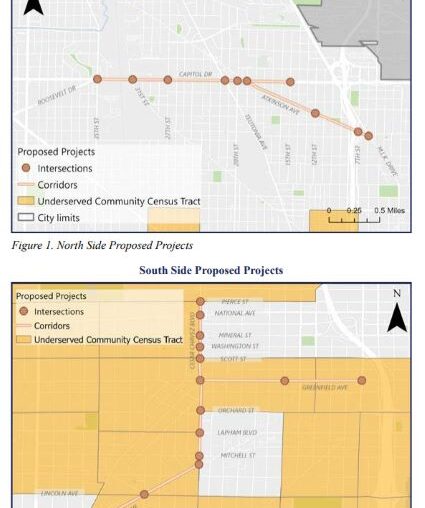Transportation
The MICAH Transportation task force advances the goals of the Jobs and Economic Development Committee by working to develop transportation channels for minorities and people with barriers to employment so they can access family-supporting jobs across Milwaukee and, especially, in the surrounding suburban communities. In keeping with MICAH’s fundamental task of addressing the systemic racism that is so entrenched in our community, destroying hope, opportunity, potential, health, and life itself, our main objective is to address the racial disparities that abound around transit issues.
We give testimony around local transportation budget issues and work in coalition with other groups to address transportation issues statewide. We support the long-range goal of establishing a regional transportation authority able to generate money to support a vibrant, multimodal, and equitable transportation system for Southeast Wisconsin. We will continue to participate in the statewide Coalition for More Responsible Transit. We are represented in current efforts to bring people together across county lines to discuss transit issues from different points of view.
The challenge for the years ahead is financial restraints at the county level which will cut back transit funding. And with road construction consuming 80 percent of the transportation budget at the state level, the need for fewer freeway lanes and more transit options looms large. Because the expansion of I-94 West with added lanes to the Marquette Interchange has again emerged as an issue, MICAH will be working with CMRT (Coalition for More Responsible Transit) to defeat any expansion and to focus on the equity issues which this presents for people of color in Milwaukee.
The City of Milwaukee will receive $4.4 million from the U.S. Department of Transportation to make pedestrian-focused improvements to 26 intersections identified as part of the Department of Public Works(DPW) high-injury network analysis.
It’s part of an $800 million award announced Wednesday by the federal department as part of its new Safe Streets and Roads for All grant program funded by the Bipartisan Infrastructure Law.“Every year, crashes cost tens of thousands of American lives and hundreds of billions of dollars to our economy; we face a national emergency on our roadways, and it demands urgent action,” said U.S. Transportation Secretary Pete Buttigieg in a statement. “We are proud that these grants will directly support hundreds of communities as they prepare steps that are proven to make roadways safer and save lives.”
DPW will use the funding to make improvements to intersections along W. Capitol Dr. from W. Roosevelt Dr. to N. 15th St., W. Atkinson Ave. from W. Capitol Dr. to N. Martin Luther King Jr. Dr., S. Cesar Chavez Dr. and S. 16th St. from W. Pierce St. to W. Forest Home Ave., W. Greenfield Ave. from S. 6th St. to S. Cesar Chavez Dr. and W. Forest Home Ave. from W. Lincoln Ave. to S. 16th St. The five corridors intersect to form two clusters, one on the North Side and one on the South Side.
Planned improvements include replacing traffic signals, realigning intersections to shorten pedestrian crossings and reduce turning radii that enable high vehicle speeds, closing approaches on intersections with five or more legs, installing new walk signal equipment and making intersections comply with the latest Americans with Disability Act standards including curb extensions and refuge islands.
“All five corridors experience very high transit usage and feature land uses that include a mixture of high-density commercial uses, libraries, schools including large high schools, parks and recreational facilities, and high-density residential developments including senior facilities,” says the city’s grant application. “These types of nearby destinations are vital to the lives of all roadway users, including children, older adults, persons with limited mobility, people of color, and economically disadvantaged populations. The proposed project aims to make these nearby destinations safe and accessible for all roadway users, particularly the most vulnerable.” The main objective of the effort, according to the application, is to improve pedestrian safety and comfort.
As part of the grant agreement, the city will need to cover 20% ($1.1 million) of the $5.5 million project cost. The majority of the project cost, $2.75 million, is to fund the construction of pedestrian corner and median improvements. An additional $1.04 million would cover the cost of accessible pedestrian signal installations. The project budget also includes design and community outreach work.
Construction on the improvements would take place in 2025 according to the city’s grant application.
Seven other Wisconsin entities won grants as part of the program: Madison, Park Falls, Brown County, Kenosha County, St. Croix County, the Milwaukee County Department of Transportation and the Lac Courte Oreilles Band of Lake Superior Chippewa Indians.
Mayor Cavalier Johnson, who tweeted a photo of himself talking on the phone high up in the US Bank Center tower, said Buttigieg called to deliver “the good news” that the city was successful in its request.

